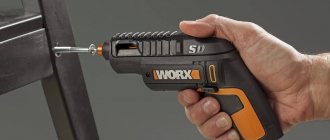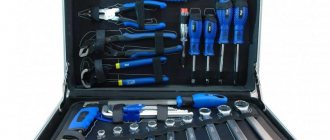14189 1 3
Petr Pirogov May 16, 2018
I'm short on space in my garage, and when my workbench ran out of space, I decided to move most of my tools to the wall. Today I’m ready to tell you how I managed to properly organize their storage.
Step 10: Vise Holder
For portable vices, I cut out two hooks from wood. They fit into slots on the sides of the vice and hold it in place. This makes it easy to remove the tool if necessary.
Bottles or canisters
Another convenient option is to use cut plastic bottles or canisters for storage. The volume is selected individually, trimmed to the required height. Canisters are suitable for larger components. The only drawback is the lack of lids, but if plastic containers are considered as an option for storing tools in a closed garage, then even metal products are not afraid of atmospheric phenomena.
The advantages of this method are obvious: containers for such placement are free. If you choose no less convenient closed containers, then you will have to spend money on their purchase. Although, if you consider the one-time investment, it is worth it: the ability to choose containers of different volumes, hermetically sealed, which can be stacked on top of each other, is attractive.
Step 11: Hammer Holder
These hammers are held in place just like open-end wrenches—furniture dowels at a slight angle hold the tool to the wall.
Storage organizers - what are they?
In everyday life, there are constantly many tools around us that need to be kept in perfect order. Organizers, which vary in appearance, material and location, cope well with this task.
The main task of storage systems is to systematize equipment according to certain criteria - this could be the intended purpose, size, etc. Tools can be stored around the house or even in the garage.
In the first case, you will need organizers that can accommodate everything you need, and at the same time will take up little space, and in the second case, you should rationally distribute all the equipment that is available throughout the room so that it can be seen and there will be no inconvenience when use.
Organizers for tools can be:
- Plastic.
- Wooden.
- Combined.
Please note that their size will depend on the contents - the larger the instrument, the larger its storage space. The advantage of storage systems is that they can be made by hand, selected for specific conditions and needs, and this will make their use more rational and convenient.
Step 12: Marking Tool
A block was made for the core, in which I drilled a small hole the size of the diameter of the tool. Then I used a bandsaw to cut off the front of the holder and drilled a hole to mount it on the wall.
Technology for creating a wooden tool rack in the garage with your own hands
Before you create a storage rack with your own hands, you need to decide on the total number of tools that need to be placed.
The tool must be placed on a vertical stand in a safe position.
Creating a project - important points
To make the wall system convenient, draw up a plan-drawing of the future structure on paper, which takes into account all the requirements for the system:
- Calculate the height and width of the rack - it is better to use the entire wall from bottom to top.
- The recommended depth of niches for shelving is up to 65 cm, and the width between the vertical supports of the shelves is up to 1 m.
- Determine the required number of shelves, including how many holder shelves with cuts for tools.
- At the bottom there are spacious floor shelves and racks for tires, wheels and large carpentry tools.
- Mark places for magnetic tapes, hooks, and holders.
- They calculate how many organizers and containers are required, what sizes, and also determine their location.
- Sort tools and all small fasteners and parts for storage.
What you will need
To make a rack, prepare the following tools:
- measuring tape, square, level;
- saw, grinder;
- fasteners;
- hammer, drill.
It is recommended to drill holes in shelves and containers for natural ventilation. This is necessary to protect items from rust.
What materials need to be prepared
All the necessary material to create the rack is prepared according to the drawn up project:
- For the main panel of the holder, you can use a perforated panel.
- If the rack is made of wood, it is recommended to purchase oak or pine lumber without cracks or knots.
- Wooden boards up to 2.5 cm thick will be required for shelves.
- Shelves can be made from regular and laminated plywood.
- The vertical posts of the frame are made of 10x10 cm timber.
- It is recommended to pre-treat wooden boards with anti-mold and mildew agents and paint them.
- To assemble a metal frame, you need a rectangular profile and corners (up to 2 cm).
Manufacturing of components
The procedure for manufacturing the rack and components is as follows:
- Vertical racks made of timber and boards or plywood are cut into shelves according to the given dimensions, and a perforated panel is prepared. Mark out places for shelves.
- To make a metal frame, cut blanks of the required height with a grinder and mark the locations of the shelves. The frame is assembled using fasteners and corners. A primer is applied, then the parts are coated with anti-corrosion paint.
- The shelves are assembled from boards. They are pressed tightly together and nailed together with nails or screws.
- Shelves from boards are assembled by laying elements across the frame, so they can withstand a lot of weight. If the shelves are assembled by laying boards along the frame, then there is a chance that they will sag under the weight of the tools.
- The structure is assembled using self-tapping screws, nails and wood glue.
- The joints of all parts are additionally reinforced with metal corners.
- The entire structure is installed on the wall and secured with metal brackets.
- Shelves with grooves, holders, magnetic tapes, racks, containers and organizers are manufactured separately in the required quantity.
- You may need a small workbench with a vise made from wooden boards. It can be attached to the wall system as a fixed or folding surface on metal or wooden holders.
Step 15: Stencil and Protractor Holder
I have a large and a small protractor. Each of them has the same holes, which allowed us to create a simple holder.
How to choose the right one
To choose the right type of organizer, you should have a clear idea of why you are choosing it, for what needs, and for what instrument. If you need to carry tools with you all the time while working, then the ideal solution would be a suitcase or case that has optimal dimensions, weight and a comfortable high-quality handle. If the tools are at home, then it is worth making a stationary structure for them and determining a place for each of the items.
You should purchase or create an organizer taking into account what exactly will be in it. For a large number of small parts, the best option would be a product with many compartments, where you can evenly distribute all the little things that are available. For large-sized devices, you should purchase or even make a special container, which will be designed for a certain type and quantity of equipment.
In order to be able to make small repairs at any time or help someone out, come to the rescue, you should have a travel organizer bag, which will contain the minimum and most necessary set of tools that can be used for different life situations. It is always important to have such an option in a car or workplace, because its small size and excellent spaciousness will make it possible to position it in such a way that it does not interfere with anything, but will help out if necessary.
When choosing an organizer, also pay attention to the material. By the way, for this task they often use something reliable and durable - high-quality metal or wood, and for occasion sets you can use textile bags. For stationary storage, plastic is the best option.
Step 16: Small Item Holders
For the rest of the tools I made simple holders, simply adjusting them to the profile. For example, for drills I cut out the mount in the shape of a plastic box, for pencils and watches - in the shape of a box, etc.
Important! Some instruments are additionally reinforced with small nails.
Cardboard tubes
Few people know that toilet paper rolls and paper towels can also be used to create insulated containers for storing small items. To do this, take a cardboard box and insert cardboard sleeves into it like pencils into a pencil holder. They are tightly fixed due to the contact of the walls, and you can put anything inside, from folded wires to radio components. For ease of use of the system, you can wrap several tubes with tape, thereby fastening them together.
Hanging shelves
Hanging shelves are highly mobile: they can be easily moved from one place to another if the situation requires it.
The second advantage of this type is ease of assembly. Almost anyone can make such a shelf with their own hands. On the other hand, such shelves are quite unstable; they sway at the slightest touch.
Shelving cabinet
The shelving cabinet is perfect for a small room. The cabinet is placed along one of the walls, forming an area for tools. The shelving cabinet can be built in the form of one long shelf, or have several shorter ones.
The second advantage of a shelving cabinet is the stability of the structure, thanks to which larger and heavier tools can be stored on it.
Of course, the rack does not have the mobility of a suspended shelf, so its location needs to be thought out more carefully.
Criterias of choice
For those who are not ready to start making shelves themselves, there is always the option of buying a ready-made device of the desired shape, size and functionality.
However, even if you have any organizer in mind, consider the following selection criteria, selected by experienced craftsmen:
- Material: Choose metal structures as they are guaranteed to last longer.
- Dimensions: choose a model that is not too bulky or too miniature.
- Load: Consider how much load the shelf can support and relate this to the tools you have at your disposal.
- Adjustment of dimensions and design parameters: if you need to modify your shelf, it is better to purchase a model that will consist of removable blocks.
Operating rules
In order for the tool organizer to last as long as possible and not need to be repaired or made new, you should be able to handle it correctly:
- The general structural condition should be checked from time to time.
- If the material needs to be regularly treated with agents against damage and wear, then this should be done on time.
- You should not try to accommodate as many tools as possible and exceed the limit that was set at the stage of creating the drawings.
- Portable structures should be placed carefully in the trunk of a car or on the floor to avoid deformation.
- If there are latches and locks, you should open and close them carefully, without haste, so as not to damage them prematurely.
Please note that if you know all these rules and apply them, you will be able to use purchased or homemade organizers for a long period of time without compromising their overall condition.











